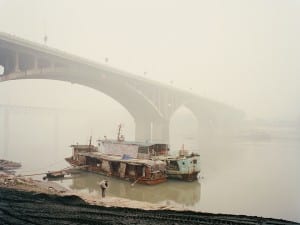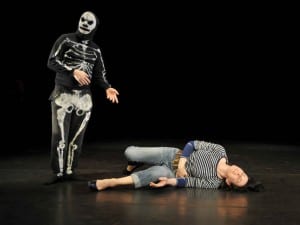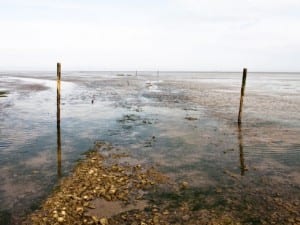A new exhibition traces the latest developments in the world of fashion, its international influences and its increasingly comfortable relationship with the institutions of fine art.
In the past 10 years avant-garde fashion has focused on a select number of designers who produce truly innovative pieces and redefine the boundaries between fashion and art. Fashion houses such as Comme des Garçons, Vivienne Westwood and Alexander McQueen consistently explore new and exciting approaches to the concept of what fashion is and the ideas the human body can present. Now, hoping to invite greater international attention for new designers beyond this core few, the Museum Boijmans Van Beuningen, Rotterdam, argues that there has never been a greater time for forward-thinking, challenging fashion designers and that the dichotomy between fashion and art has never been less clear.
The Future of Fashion is Now focuses on the immensely diverse range of directions that today’s designers, both new and those that are more established, are navigating into. With existing works from more than 60 designers from around the world, as well as special new commissions from six emerging talents, the exhibition runs the gamut from fashion for fun, fashion for ease of use, fashion as a challenge to design, to fashion which even challenges the very idea of fashion itself.
Conceived by José Teunissen and Han Nefkens, The Future of Fashion is Now explores the huge changes and progressions of the fashion industry in recent years. Teunissen explains that now feels like the right time for the exhibition: “We have been aware for some years that there’s a new generation, which is thinking really differently about fashion.” On the one hand, she attributes changing attitudes to advances in technology which have “emancipated people, so that more and more designers want to experiment with new kinds of material, new kinds of solutions” and on the other hand to a growing awareness that the avant-garde designers “working on the edge of fashion” have themselves become well-known pillars of the establishment. Teunissen describes people such as Rejina Pyo, Hussein Chalayan and Viktor & Rolf as “more conceptual, working fashion designers, who are constantly trying to renew fashion, experimenting with what it could be” but these are professionals who have been challenging the status quo for a long time. The Future of Fashion is therefore also “about broadening our scope, looking outside Europe and maybe seeing what’s happening in China and Peru and Australia.” The exhibition brings a truly international flavour to innovative fashion because “the world has changed; every important city or region of the world has its own fashion, fashion weeks and magazines.”
While pieces were collected by the curators with the help of international scouts and a jury, the process of selection was deliberately non-prescriptive and the range of designs on view is a natural presentation of highly eclectic global styles. They were, however, able to break down the presentation of the exhibition into four “sub-terms.” These sections focus on Materialism (transparency, organic and technology), Carnivalesque (redefining body form and identity), Reinterpretation (journeys and explorations), and Politics and Community. This thematic curation avoids placing too much physical distinction between the previously existing works and the six commissions which were especially created for the show. The newly-created works are to be placed amongst the other works in their appropriate thematic area but will be superficially set apart with more space and explanatory text around them. Although displayed alongside many other works, these new commissions are the focal point of the exhibition and they enable the curators to highlight the new directions open to and pursued by the innovators when they are released from the industry’s commercial and financial constraints.
The six successful winners were each awarded a grant from the Han Nefkens Fashion on the Edge initiative to create a piece that they felt was important to make. To identify the recipients, Teunissen and Nefkens undertook “bottom-up research” and nurtured the designers by constantly discussing their ideas and aims. The final recipients – Craig Green (UK), Digest Design (China), D&K (Australia), Iris van Herpen (The Netherlands), Lucia Cuba (Peru) and Olek (Poland) show variety and the wider trend of fashion, rather than focusing on the established fashion capitals of London, Paris, New York and Milan. The industry is looking further afield, especially to Berlin “for avant-garde, for margin, for new” and also to Antwerp for “new energy, new possibility.”
Although these six designers were funded by Fashion on the Edge, there was no prescription for their work and they were given creative free reign over their final designs. Teunissen and Nefkens, however, encouraged a process of creative collaboration, which Teunissen describes as “a dialogue, to stimulate them, to inspire them to control it.” So while the commissions were “especially meant to give designers the freedom to make something that they want to make that they probably wouldn’t make,” the curators closely followed the progress of each designer: “It’s not about (critiquing) them; it’s more about seeing how the process is developing, for example, and asking how something will evolve and what kind of project it is?”
For centuries clothes have been used, not just for practicality, but as a way of projecting an image and appearance to the rest of the world. This is one of fashion’s very strengths, the manner in which it acts as a form of sociological armour for its wearer. Teunissen describes this ability “to communicate a personal and social identity” as “the most important aspect of fashion, for centuries.” Designers such as Adele Varcoe (one of a number of those in the exhibition currently undertaking a PhD) are focusing on these sociological myths of clothing, with Varcoe directly referencing the story of the emperor’s new clothes fairytale and its message of the powerful projections of fashion. By creating several performances only body stockings are worn (including a reconstruction of a 1920s Chanel show, without the clothes) Varcoe questions “what is concrete and material and what is just a culture and a belief in the visual elements.” Meanwhile, Forrest Jessee is taking fashion back to its most basic and exploring how clothing can be used practically and how new technologies can be manipulated to recreate comfort and protection. Jesse’s Sleep Suit is a form of “architecture connecting to something you can wear,” a comforting cocoon that is simple but maintains an avant-garde appeal.
Some designers have taken the possibilities and innovations of technology further still to create pieces that ostensibly seem useful and practical but which would take some stretch of the imagination to become mainstream and populist. Pauline van Dongen’s re-charging jacket, for example, certainly brings functionality to a new extreme but, while it’s doubtful that these items will ever become a commercial reality, Teunissen argues that “the use of technology is gaining momentum … the challenge is to make a product, not a prototype.” Elisa van Joolen’s work directly acknowledges both the potential of customisation and the cannibalism of fashion by reproducing a variety of crew neck sweaters from different designers into new pieces. The project acknowledges not only the similarities among many different designers’ ranges (“everyone has a crew neck sweater, every brand”) but also, once the work leaves the fashion house, it is in the public realm and out of the designer’s control. Just as red carpet fashion designers have sought over the years to have the “right” celebrities photographed in their clothes, Teunissen explains how van Joolen found that many of the original designers “tried to control it.” However, the beauty of a garment lies not only in the way in which it hints at continued possibilities for individualism in a rather homogenous landscape: “Everything looks the same, but when you make new combinations, you see small differences in the brands; I think that’s simple but nice.”
Van Joolen’s work indirectly references the manner in which fashion, and our relationship to it today (the constant pursuit of the new, the revolving door of collections and the fast fashion on the high street) raises ethical issues and questions about the industry’s sustainability. Designers such as Stella McCartney and Vivienne Westwood have for years advocated a more ethical, sustainable, environmentalist attitude, but this is contradictory because they are a part of this system and the constant search for the new. Teunissen, however, sees the introduction of new technology as an opportunity to challenge this status quo. The new technologies have “opened up space for young designers because they can start within a niche making a small-scale product and find new business models with small-scale, highly specialised, unique things; that’s valuable.” While challenging the mores of consumerism, they are rising to prominence using technology that has made the bigger brands take notice. With retail giants from Burberry to Primark recognising the significance of use of social media in engaging with customers, fashion is one which embraces greater individuality both the brands for consumers.
The exhibition’s very title, The Future of Fashion is Now, identifies the insatiable search for the new that powers this global industry to constantly seek novelty and change. However, it also acknowledges that there has never before been a time like this in fashion. In defining the art form and its status today Teunissen sees the innovations in materials and technology as leading the way: “Changing the process and also the content of fashion, making clothes that communicate with your body and present its emotions, that brings a totally different image or meaning of what fashion could be.” Just as important, however, is the fact that emerging designers are starting to question and re-think the system of fashion and consumption: “More and more there is the ethical issue. Do we have to consume this? Don’t we have to think more about the value of what we are wearing?” Teunissen calls this new ethical issue “sustainable awareness” and highlights that in many ways this need for a story, a focus on the provenance of a piece, and an awareness of the models at work in its creations, is bringing fashion closer to art. The idea of stories in a work is common in fine art but “the specific connection to fashion, to garments, to textiles, to raise awareness of these kinds of stories, to connect people, I think that’s quite new in fashion.”
An example of using a garment that takes the narrative of creation and weaves it explicitly into the final work is Dutch designer, Aliki van der Kruijs’ Made By Rain scarves. They are dyed in indigo then literally laid out on the designer’s roof until it rains. Because it is such an organic process, and totally at the whim of nature, each piece is unique in a way that factory-made (or even hand-made) materials cannot be. Each textile comes with a card stating which date’s rain helped to create it, how strongly it fell and for how long, and this brings an element to the design that Teunissen describes as “slow fission.” This focus on materiality and the process of making is echoed in Digest Design’s recent commercial fashion collection, which explores the versatility and uses of calico. Using traditional methods of dying, Digest Design (designer Dooling Jiang) has created a reconstruction from her previous collection, referencing not only “local craft and local heritage reflecting China’s identity,” but also the more commercial collections of fashion designers and the fusion of fashion with art by then creating something akin to an artist’s installation – a composition which Teunissen describes as “bringing forward Chinese history, connecting it to the values of fabric.” For Teunissen this story-telling is a really important element of the new direction in which fashion is moving: “Why are we attached to clothing? What can be the story? What is relevant? It’s a different, conceptual, more art way of thinking than 10 or 20 years ago.” This redefinition of values is a process that extends beyond the exhibition to each designer’s practice and research and, because of the fashion world’s insatiable search for the new, it’s a story that will keep on evolving on the catwalk and on the street.
The Future of Fashion is Now runs at Museum Boijmans Van Beuningen
11 October – 18 January. For further details, visit www.boijmans.nl.
Ruby Beesley





